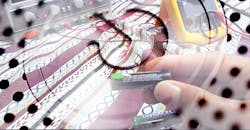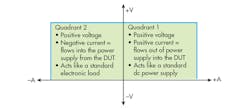Download this article in PDF format.
Test engineers turn to programmable power supplies when they need to apply power to their device under test (DUT). Sometimes, the DUT has a small amount of stored energy that needs to be removed during the test. Taken to an extreme, the DUT may itself be an energy generator, whereby testing requires the continuous absorption of power (i.e., loading down the DUT).
Let’s consider the case of the DUT having a large capacitor on the main dc power input. When powering the DUT, the power supply must first charge the DUT’s large input capacitor, let’s say to 48 V. With a properly sized power supply, you can source a lot of current and drive up the voltage on the capacitor. A typical power supply can make the required voltage change of 0 to 48 V in 20 ms.
Later in the test, you want to go in the other direction and change the voltage on your DUT from 48 V back down to 10 V. The stored energy in the capacitor must go somewhere to discharge the capacitor and bring its voltage down. If no special provision is made in the power supply, the capacitor’s only discharge path is to discharge back into the DUT. If the DUT is a power-hungry device, the capacitor will discharge quickly and the voltage on the capacitor will drop until the power supply’s regulated output-voltage set point of 10 V is reached. At that moment, the energy will resume flowing from the power supply into the DUT’s capacitor to maintain the 10 V on the capacitor.
Capacitor Discharge
In most power supplies, some provision is made to discharge the capacitor. The simplest and oldest method is to use a bleed resistor. This is a fixed-value resistor that’s across the terminals of the power supply internal to the supply. The purpose of the bleed resistor is to draw down the power supply’s own output filter capacitor. However, the bleed resistor also forms a path for the energy to flow out of the DUT back into the power supply.
Bleed resistors are very simple, but they don’t work very well. The amount of current flowing in the resistor is proportional to the voltage across the resistor (which is the programmed output voltage of the power supply). So, at low voltage, the current is low and the bleed down time is lengthy. Also, they typically can’t handle a lot of current. Lastly, as a fixed value resistor, the bleed resistor doesn’t allow for any flexibility or control over the bleed-down operation.
A better approach is an active down-programmer. Rather than a simple bleed resistor, the down-programmer is a transistor circuit that acts like an electronic load built into the power supply. The active down-programmer is turned on when the power supply needs to lower its output voltage. The down-programmer rapidly draws off the energy stored in the output capacitor and can even dissipate energy stored in your DUT’s input capacitor. Effectively, it sinks the current from the capacitors back inside the power supply.
Of course, the down-programmer circuit has limitations. As an electronic load inside the power supply, it must dissipate the energy as heat. This means the down-programmer circuit gets hot, needs a heat sink, and adds to the size and weight of the power supply. The added heat within the power supply means it generally has larger fans to manage the heat. Active down-programmers may be limited in the amount of current they can draw (typically 10% of rated power-supply output current) or they may be limited to the total energy they can draw (stated in terms of duty cycle of down-programming time to up-programming time).
1. Here’s the output characteristic of a two-quadrant power supply, which combines a supply and electronic load.
But what happens when the DUT stores a lot of energy? The active down-programmer is meant to operate in a transient manner to only remove excess energy to bring the voltage on the output of the power supply down to a new programmed value (and hence the name “down-programmer”). In the case where the DUT stores a lot of energy, such as a supercapacitor bank or a battery, you need a down-programmer that can run at a continuous high power level. In other words, you need the power supply to act like an electronic load.
A power supply that combines a power supply and electronic load within a single instrument is called a two-quadrant power supply, because it can operate in two quadrants (Fig. 1). These supplies always generate positive voltages, but are capable of sourcing current (positive current) or sinking current (negative current). They’re particularly well-suited for testing batteries or battery-charging circuits, where the power supply must sometimes source current (as in the case of charging the battery) and sometimes sink current (as in the case of discharging the battery) (Fig. 2).
2. The Keysight Advanced Power System (APS) is a family of dc power supplies consisting of 24 models at 1,000 W (top) and 2,000 W (bottom). These two-quadrant power supplies can both supply power and act like a constant-current load, while offering best-in-class current measurement accuracy. (For more information, go to www.keysight.com/find/APS.)
So far, no matter which energy dissipation method is used, you’re faced with the challenges of heat generated in the power supply by the bleed resistor, down-programmer, or integrated load circuitry, during the time when the energy is being absorbed from the DUT back into the power supply. The heat is dissipated by large heat sinks that are cooled by fans.
Regeneration
3. The Keysight RP7900 family offers 5,000-W and 10,000-W two-quadrant regenerative dc power supplies. When operating as an electronic load to absorb energy from the DUT, the energy is placed back on the ac line for efficient operation and reduced heat. (For more information, go to www.keysight.com/find/RP7900.)
An emerging technology in laboratory-grade instrumentation power supplies is energy regeneration. Rather than having the DUT’s energy enter the power supply and be dissipated as heat, these modern supplies take the energy and put it back onto the ac line (Fig. 3). This gives several benefits:
- Less heat is generated inside the power supply, so it runs cooler and is more reliable.
- Less heat is generated inside the power supply, so it doesn’t need large heat sinks and fans and thus can be smaller.
- The energy that’s recovered can be used again by other items connected to the ac line, lowering the electricity consumed and the operating costs of the engineering laboratory.
Due to the added cost of the ac regeneration circuits, regenerative power supplies are mostly built for high-power applications, starting at 5000 W, where the reduced operating costs and size reduction of the equipment can have a significant payback.
About the Author
Bob Zollo
Solution Architect for Battery Testing, Electronic Industrial Solutions Group
Bob Zollo is solution architect for battery testing for energy and automotive solutions in the Electronic Industrial Solutions Group of Keysight Technologies. Bob has been with Keysight since 1984 and holds a degree in electrical engineering from Stevens Institute of Technology, Hoboken, N.J. He can be contacted at [email protected].





